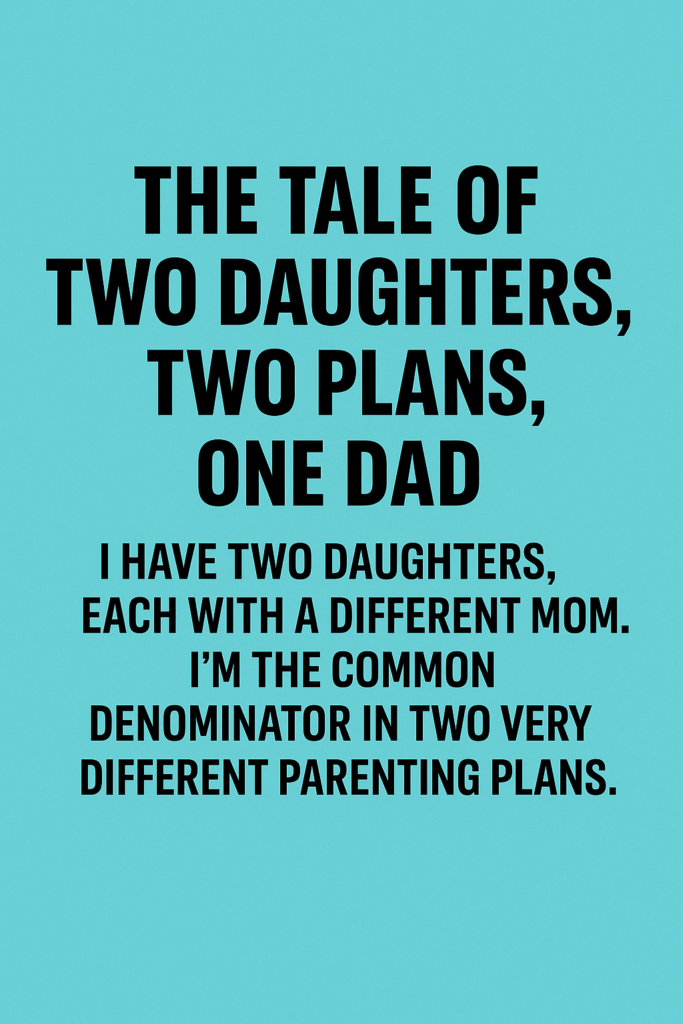
When I first started fighting custody battles, I thought fairness was a math equation. Half with me, half with Mom. Fifty-fifty. A neat, symmetrical split that would prove I was a good dad.
But here’s the problem: many parents assume equal time = fair time. That belief traps families in years of conflict. Kids aren’t pie charts. They don’t live in neat halves—they live in routines, meltdowns, sleepovers, soccer games, and the occasional “forgot to tell you about the science project due tomorrow.”
What looks “fair” on paper often creates chaos in real life.
The Tale of Two Daughters, Two Plans, One Dad
I have two daughters, each with a different mom. I’m the common denominator in two very different parenting plans.
With my oldest, I wound up with 35.7% parenting time—five overnights every other week. Later, after a relocation, the schedule shifted again. These days, I have summers and holidays. Her mom and I had to work through what that relocation would look like. And we did it—not without fear at first. Moves are scary. They threaten stability. But life happens, and moves happen. To make it work, maturity was a must.
With my youngest, I share a true 50/50 split. Week-on, week-off, with the bonus of living just ten minutes from her mom. That closeness gives her a kind of freedom: she can bounce between our homes easily. In fact, it got so loose at one point that her mom and I had to crack down when she started “working the system,” playing us against each other to get her way. (If your kid ever pulls that one off, congratulations—you’ve unlocked “advanced co-parenting mode.”)
Here’s the kicker: both daughters are thriving. The “fairness” wasn’t about percentages—it was about stability. And that’s the real problem parents miss: chasing 50/50 as a definition of fairness blinds them to what actually works.
The Myth of 50/50 Fairness
The belief many parents hold is: If we split time equally, it must be fair.
The reality: fairness for parents doesn’t always equal stability for kids.
When parents push 50/50 as the only definition of fairness, here’s what can happen:
Kids feel unsettled. Constant transitions can leave children feeling like they live out of a suitcase, especially when homes are far apart or schedules lack consistency.
Parents start keeping score. Instead of focusing on the child, both sides can slip into tallying overnights like referees in a game nobody wins.
Conflict gets amplified. Vague plans leave room for loopholes, while overly rigid ones can’t handle life’s curveballs—both scenarios often drag families back into court.
Logistics outweigh well-being. Long commutes, school boundaries, and work schedules may turn “equal” time into unequal stress.
Developmental needs get overlooked. Very young children often benefit from shorter, more frequent contact; teenagers may need longer stretches in one home. A one-size-fits-all 50/50 ignores these stages.
Safety concerns can be minimized. In cases where one parent refuses to address harmful behavior, equal time can actually undermine a child’s best interest.
Fairness isn’t about symmetry. It’s about stability, predictability, and aligning the plan with the real needs of the child.
The Hidden Costs of Chasing Equality
When parents chase equal time instead of stable time, the price often isn’t obvious at first. But it shows up in ways that strain both the family and the kids:
Disrupted rhythms. Kids don’t measure fairness in alternating Tuesdays—they measure it in whether their routines feel steady. Homework, friendships, and sleep schedules take a hit when the plan is designed around symmetry instead of stability.
Parent burnout. An “equal” schedule on paper can be unequal in practice if one parent is juggling overnight shifts, long commutes, or other constraints. That strain often builds resentment, which spills over into how parents relate to each other—and to their kids.
Conflict inflation. Without airtight language, even small differences can balloon into full-blown disputes. The courtroom becomes the tiebreaker, not because of malice, but because of loopholes.
Flexibility gets strangled. Rigid “equal time” schedules often collapse the first time life throws a curveball—illness, travel, or a new job. Instead of adapting, parents argue about who “lost” time.
Kids feel the fallout. Behind every fight over hours and percentages is a child who absorbs the tension. Equality on paper means nothing if peace is absent in practice.
This is the trap: mistaking equal slices of time for a healthy environment. True peace isn’t carved from fractions—it’s built through stability and cooperation.
What Works Better: Child-Centered Fairness
The solution? Redefine fairness. Not as arithmetic, but as alignment.
Strong plans focus on:
Age-appropriate schedules: Like 2-2-3, 2-2-5-5, or week-on/week-off. (Yes, those are all 50/50 schedules—but they work differently depending on the child’s age and needs.)
Real-world logistics: jobs, geography, and travel demands.
Predictability: so kids know what comes next and parents don’t have to constantly renegotiate.
Let me be clear: as a dad, I absolutely support awarding 50/50 when it’s in the best interest of the child. But I’ve coached both moms and dads who see not having 50/50 as a “loss”—as if the other parent “won.” That’s not the case. Sometimes the best interest of the child looks like 50/50. Sometimes it’s 60/40, or 30/70. And sometimes, when a parent refuses to change harmful behavior, the best interest may even require restrictions.
Best interest is not math—it’s about what keeps a child stable and safe.
The Payoff of Peace
Here’s the difference I’ve lived:
Weak, loophole-riddled plans = endless court.
Strong, airtight plans = freedom and peace.
From 2014 to 2020, I was in and out of family court so often I could’ve asked the bailiff for a loyalty card. Since 2020? Court-free. Since 2025? Real autonomy. Not flawless, not without bumps, but enough that I can parent without the gavel hanging over my head.
The women I once saw as adversaries are no longer opponents—they’re simply the mothers of my daughters. Court orders still exist, but they’re like fire extinguishers: good to know they’re there, but better if you never need to smash the glass.
And whether you believe me or not—or think I’m smoking something—I want to send a reminder: I’m likely living the life many parents dream about with their children. Strong peace. Clear boundaries. And workable relationships with my exes. That’s possible.
Action Step: Stop Asking “What’s Fair to Me?”
The problem is asking the wrong question. The solution is flipping it.
Instead of: What’s fair to me?
Ask: What creates stability for my child?
That one shift gets you out of the scorekeeping game and into a co-parenting dynamic that actually works.
If you’re ready to build a plan that works in real life—not just on paper—that’s what the Ironclad Parenting Plan Strategy Kit was built for. It solves the problem most parents never even name: the trap of mistaking equal time for true fairness.
Because parenting time isn’t about perfect math. It’s about peace.
🔎 Disclaimer
This article shares my lived experience and insights from coaching. It’s meant for educational purposes, not legal advice. Every family’s situation is unique, so always consult with a qualified professional when drafting or modifying your parenting plan.
